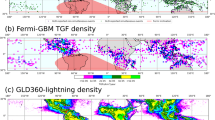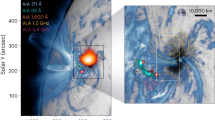Abstract
IN 1932, Bartels put forward the hypothesis that moderate geomagnetic storms with gradual commencements were associated with certain active regions on the sun which he called M-regions. Solar and geomagnetic studies in later years have confirmed the existence of these magnetically effective areas; but their exact nature still remains obscure. Some authors consider them to be regions from which sunspots have just disappeared, leaving behind a certain amount of activity; others regard them as long-lived dark filaments emitting slow corpuscles and closely connected with bright coronal patches. Our knowledge about the origin of the more intense geomagnetic storms, on the other hand, is more certain. These are characterized by sudden commencements and show very close correlation with solar flares, which occur in the neighbourhood of spot-groups. Observational results of recent years have provided satisfactory evidence of the emission of both corpuscular and electromagnetic wave radiations from intense solar flares; the geomagnetic storm associated with a flare is due to the corpuscles and commences about one to two days after the optical observation of the flare, and the ultra-violet component of the wave radiation produces, in favourable circumstances, a ‘crochet’ in the magnetic traces synchronously with the flare, while the longwave component in the radio-frequency region appears as a noise-burst almost synchronously with the flare. But, to our knowledge, no observational evidence has so far been published indicating that M-regions also can produce crochet-like disturbances in geomagnetic records and simultaneously emit radio waves similar to the noise-bursts from flares. The evidence provided by our recent observations in this regard is therefore of interest.
This is a preview of subscription content, access via your institution
Access options
Subscribe to this journal
Receive 51 print issues and online access
$199.00 per year
only $3.90 per issue
Buy this article
- Purchase on Springer Link
- Instant access to full article PDF
Prices may be subject to local taxes which are calculated during checkout
Similar content being viewed by others
References
Wulf, O. R., and Nicholson, S. B., Pub. Astro. Soc. Pac., 60, 37 (1948).
Kiepenheuer, K. O., Astrophys. J., 105, 408 (1947).
Author information
Authors and Affiliations
Rights and permissions
About this article
Cite this article
DAS, A., BHARGAVA, B. Radio Noise-bursts from Solar M-Regions. Nature 172, 855–856 (1953). https://doi.org/10.1038/172855a0
Issue Date:
DOI: https://doi.org/10.1038/172855a0
This article is cited by
-
Kodaikanal Solar Observatory Radio Spectrograph
Solar Physics (2021)
Comments
By submitting a comment you agree to abide by our Terms and Community Guidelines. If you find something abusive or that does not comply with our terms or guidelines please flag it as inappropriate.



